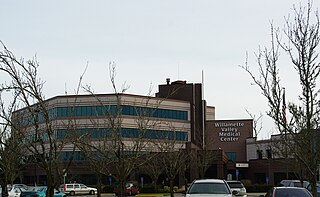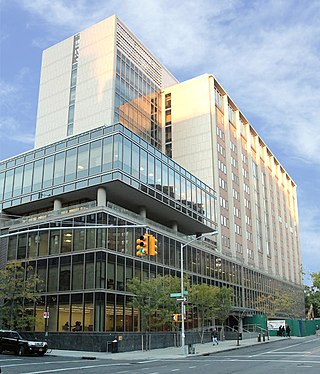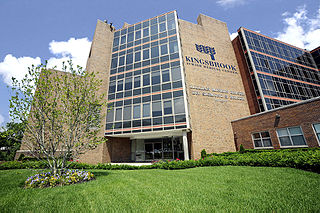In the United States, a health maintenance organization (HMO) is a medical insurance group that provides health services for a fixed annual fee. It is an organization that provides or arranges managed care for health insurance, self-funded health care benefit plans, individuals, and other entities, acting as a liaison with health care providers on a prepaid basis. The Health Maintenance Organization Act of 1973 required employers with 25 or more employees to offer federally certified HMO options if the employer offers traditional healthcare options. Unlike traditional indemnity insurance, an HMO covers care rendered by those doctors and other professionals who have agreed by contract to treat patients in accordance with the HMO's guidelines and restrictions in exchange for a steady stream of customers. HMOs cover emergency care regardless of the health care provider's contracted status.

Kaiser Permanente is an American integrated managed care consortium, based in Oakland, California, United States, founded in 1945 by industrialist Henry J. Kaiser and physician Sidney Garfield. Kaiser Permanente is made up of three distinct but interdependent groups of entities: the Kaiser Foundation Health Plan, Inc. (KFHP) and its regional operating subsidiaries; Kaiser Foundation Hospitals; and the regional Permanente Medical Groups. As of 2023, Kaiser Permanente operates in eight states and the District of Columbia, and is the largest managed care organization in the United States.

Parkland Memorial Hospital is a public hospital in Dallas, Texas, United States. It is the main hospital of the Parkland Health & Hospital System and serves as Dallas County's public hospital. It is located within the Southwestern Medical District. The hospital is staffed by the faculty, residents, and medical students of UT Southwestern Medical Center.

Saint Louis University Hospital is a 356-bed non-profit, research and academic medical center located in St. Louis, Missouri, providing tertiary care for the east Missouri region. The medical center is a part of the SSM Health System and is affiliated with the Saint Louis University School of Medicine. SLUH features an ACS designated adult Level 1 Trauma Center and has a helipad to handle medevac patients.

The University of Pittsburgh Medical Center (UPMC) is an American integrated global nonprofit health enterprise that has 92,000 employees, 40 hospitals with more than 8,000 licensed beds, 800 clinical locations including outpatient sites and doctors' offices, a 3.8 million-member health insurance division, as well as commercial and international ventures. It is closely affiliated with its academic partner, the University of Pittsburgh. It is considered a leading American health care provider, as its flagship facilities have ranked in U.S. News & World Report "Honor Roll" of the approximately 15 to 20 best hospitals in America for over 15 years. As of 2016, its flagship hospital UPMC Presbyterian is ranked 12th nationally among the best hospitals by U.S. News & World Report and ranked in 15 of 16 specialty areas when including UPMC Magee-Womens Hospital. This does not include UPMC Children's Hospital of Pittsburgh which ranked in the top 10 of pediatric centers in a separate US News ranking.

Michigan Medicine is the academic medical center of the University of Michigan, a public research university in Ann Arbor, Michigan.
Katherine Shaw Bethea Hospital is a hospital in Dixon, Illinois. KSB Hospital is an 80-bed acute care facility providing comprehensive ancillary services, including emergency medicine, obstetrics, inpatient psychiatry, a cardiovascular laboratory, outpatient surgery, inpatient surgery, and intensive care, among others.

Grand Rapids Medical Mile is a designated area within the city of Grand Rapids, Michigan. It began with medical-related development in the Hillside District of Grand Rapids, Michigan, bordering both sides of Michigan Street. More than a decade later it encompasses an area five times larger, expanding east further down Michigan St.and north across Interstate 196. It has also been referred to as Grand Rapids Medical Corridor, Michigan Street Medical Corridor, Health Hill, Medical Hill, and Pill Hill, among other names.

Baptist Health (Jacksonville) is a faith-based, non-profit health system comprising 7 hospitals with 1,168 beds, a cancer center, four satellite emergency departments and more than 200 patient access points of care, including 50 primary care offices located throughout northeast Florida and southeast Georgia. The headquarter is in Jacksonville, Florida.

Salem Hospital is a non-profit, regional medical center located in Salem, Oregon, United States. Founded in 1896, the hospital has 454 beds. A Level II trauma center, the community hospital is the largest private employer in Salem and the only hospital in the city. Salem Hospital is one of five Magnet designated hospitals in Oregon.

Willamette Valley Medical Center is a for-profit Level III acute care hospital in McMinnville, Oregon, United States, adjacent to the McMinnville Airport on Oregon Route 18. Opened at a different location as McMinnville Community Hospital, the four-story medical center has 60 licensed hospital beds. It is owned by Lifepoint.

The Hart–Dole–Inouye Federal Center, formerly the Battle Creek Federal Center, is a complex of federal buildings located in Battle Creek, Michigan.

Gouverneur Health, formerly Gouverneur Hospital, is a municipally owned healthcare facility in New York City affiliated with the New York University School of Medicine. It is located at 227 Madison Street in Lower Manhattan. The facility offers comprehensive healthcare services, including outpatient, specialty, and skilled nursing care. It primarily serves residents of Manhattan, Brooklyn and Queens.

The Medical College of Virginia/Virginia Commonwealth University School of Medicine is the medical school of Virginia Commonwealth University, a public research university in Richmond, Virginia. It is the largest and oldest continuously operating medical school in Virginia. The school traces its beginnings to the 1838 opening of the medical department of Hampden–Sydney College, which in 1854 became an independent institution known as the Medical College of Virginia (MCV). In 1968, MCV joined with the Richmond Professional Institute to form Virginia Commonwealth University. The School of Medicine is one of five schools within the VCU Medical Center and Children's Hospital of Richmond at VCU.
OU Health is the combination of OU Medical Center – Oklahoma City & Edmond, the Children's Hospital, OU Physicians, OU Children's Physicians, the University of Oklahoma College of Medicine, and the Peggy and Charles Stephenson Oklahoma Cancer Center. OU Health focuses on improving health by collaboration, searching for innovation and encouraging high performance.

Firmin Desloge Hospital is a hospital in St. Louis, Missouri, opened in 1932 by the Jesuits of Saint Louis University and the Sisters of Saint Mary. Named for the benefactor, Firmin V. Desloge, it was established to serve the poor and others in need. Located on Grand Avenue between Vista Avenue and Rutger Avenue, Firmin Desloge Hospital is today the main hospital building of the St. Louis University Medical Center.

Kaiser Oakland Medical Center is a hospital in Oakland, California. It is located at the intersection of Broadway and West MacArthur Boulevard, immediately north of Downtown. It is the flagship hospital of Kaiser Permanente, the largest managed care organization in the United States, through its Kaiser Foundation Hospitals division.

Kingsbrook Jewish Medical Center is a 303-bed full-service community teaching hospital with an estimated 2,100 full-time employees, located in the neighborhood of East Flatbush in Brooklyn, New York. The hospital is made up of a complex of eight conjoined buildings which are dispersed over a 366,000 square foot city block.

Jacobs Medical Center is a teaching hospital on the University of California, San Diego campus in the La Jolla neighborhood of San Diego. Along with the UC San Diego Medical Center, Hillcrest, it serves as a flagship hospital of UC San Diego Health and the primary teaching hospital for the UC San Diego School of Medicine. The facility, which offers specialized care not previously available in San Diego County, opened in 2016.


















